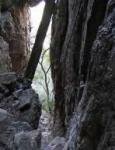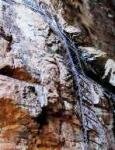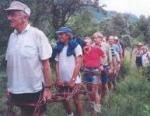Home > Trails/venues > Sunday trails > Foothold > Chain Ladder
Linked together by chains ...
Ladder Gully route


Start by following the ?‘Chain Ladder?’ arrow on the signpost next to the braai at Foothold. Pass through the gate, closing it to keep the cattle out. The trail now leads along a fence on your right; when you reach a fork in the trail, branch off to the left. Pass the ?‘0.5km?’ marker. When you come to another wire fence, turn left. Pass through the stile and head to your right (alongside the fence). Almost immediately you will veer to the left and start to climb. On your right, you will see the ?‘Koppie Loop?’ signpost. Usually, you will ignore that signpost; however, if you feel like exploring the ?‘road less travelled?’, the short Koppie Loop detour will lead you around Millenium Koppie and back to the clearing (see below). Shortly after the ?‘1.0km?’ marker you will come to a clearing with an arrowed sign to the chain ladder. Millennium Koppie is on your right. Scramble to the plaque at the top, if you wish, then rejoin the group in the clearing.
The path is well defined, and is also marked by means of red ribbons hanging from the branches of trees, and painted dots on rocks along the way. The track dips downhill for a brief stretch just before the ladder; but don?’t get your hopes up too soon! At the foot of the cliff you will pass one of the wonders of the Modern World ?– the main catchment junction for the spring water that feeds the Club?’s Foothold property. Be careful not to stand on the black plastic piping. The approach to the ladder can be tricky ?– watch out for dislodged rocks, and be careful not to dislodge any yourself. Ropes, chains and steel rings are there to help you. Once you reach the top of the ladder, a brief scramble takes you to a small plateau where you can rest and enjoy the view. A cairn includes signposts indicating that Footloose Gully lies to the west, Jubilee Gap to the east, and the chain ladder to the south (but you knew that, since you have just climbed it!)
If you head east, the trail takes you along the top of the cliff towards the cairn that marks the top of Jubilee Gap; even further east lies Marjean Pass. To the west, the trail runs along the top of the cliff towards the top of Footloose Gully and thence to another cairn at the top of the ridge. Alternatively, a short, stiff climb (including a bit of bundu-bashing) takes you straight to the top.
From the top the mountain slopes gently to the north; several kloofs with streams and pools (depending on the rainfall) lie within easy reach. To the north-east lies Souci Pools; further down the river you will come to Humdinger Pool. To the north lies Mhlabatini Kloof (out of bounds unless you have a permit, as it is Mountain Club property) and, to the north-west, Fern Kloof. The kloofs are well defined and are lined with fascinating rock formations.
After lunch you will probably head back south towards the ?‘koppie?‘ on the horizon, which lies just to the west (right) of the cairn marking the top of Jubilee Gap. At the cairn you can decide which route to follow for the return trip (Footloose Gully, Marjean Pass, Jubilee Gap, or even back down the Chain Ladder).
History of the Ladder
A tribute to all the volunteers from the Johannesburg Hiking Club and those from the Mountain Club of South Africa, for the prescience, perseverance and erection of the chain ladder at Foothold.
As the JHC did not have any routes up the mountain on it?’s own property, it was decided in 1995 to reconnaissance for a suitable route in order to reduce our dependence on our neighbours. An environmental study was conducted and with assistance of Neil Margetts, Patrick Douglas-Henry and Bruno Vogt from the MCSA, the Foothold administrator, Robert Douglas, four possible sites were recommended. The water gully was chosen.
Heavy duty mining grade chain was donated by McKinnon Chain and after weeks of cutting and welding, a low priced chain ladder evolved. The installation came next. Many abled bodies assisted in the Great Chain Haul lugging this weighty object to its resting place. Who will ever forget the backbreaking work! On 20 January 1996, the chain was doubled up and carried by volunteers to the gully.
This was followed by getting a hired generator to the site so that the drilled holes in the rock could be made to secure the pins of the ladder. This aspect took weeks as it was the wet season and often the venture would be overwhelmed by lightning flashes, thunder and heavy rain, almost as if the ?‘Mountain God?’ was trying to keep us away from our succeeding in this venture. Too many names to mention individually, but with all the willing volunteers, the chain ladder was installed and a dedication ceremony was conducted in March 1996.
The JHC is indebted to all those who contributed to this event and made the chain ladder a reality ?– even those who made the tea and cake!!!
Neil summed up the proposal on 24 July 1995 thus:
?‘Although this site has quite a steep route to follow, it is not apparently as intimidating as it could be, due to the fact that the gully is largely concealed by a large tree, and a huge choke stone which looks quite spectacular, but makes the place feel safe. The person with a fear of heights will be more confident here. In spite of the many rungs of the ladder, the top is reached surprisingly quicly. Without realising the distance, one is walking up the ledge to the top of the escarpment, - this ?‘surprise?’ adds something to the route. This route is challenging without being intimidating. The gully has a definite excitement to it.

Materials
Total chain required 26mt of heavy duty chain and 25mt of lighter chain. The ladder was constructed from twin 13mm gauge short-link inswell free chain (grade 800 Tocalloy), held apart by rungs 400mm long of galvanized water pipe, outer diameter of 21mm. U-shaped rock staples of 12mm mild steel welded over mild steel galvanized M10 nuts, anchor the ladder away from the rock face. Total project cost R7 793,51.
Phase 1: Holes for anchoring the ladder to the rock were drilled in the late 1995/DIV>
Phase 2: Transport the ladder to the site.
Phase 3: Test ?– one very heavy hiker.
Phase 4: Official opening of ladder 2 March 1996.






